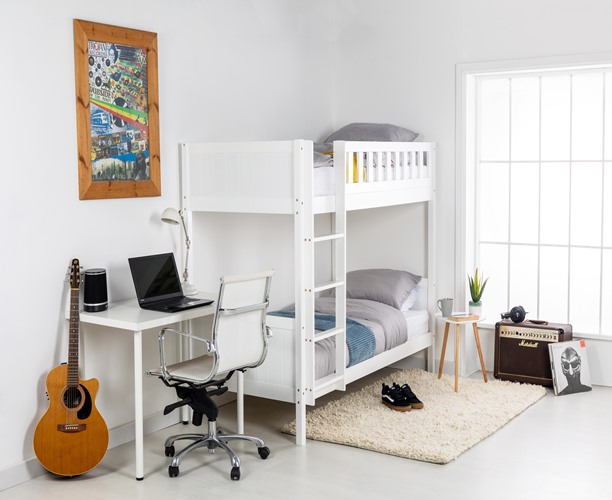Lofted bunk beds offer an exciting and practical sleeping solution for children’s rooms. These elevated beds provide a unique space-saving design that appeals to kids while addressing the needs of parents looking to maximize floor space. Durable bunk beds at BedKingdom create additional room for play, study, or storage underneath, making them an attractive option for smaller bedrooms or shared spaces.
Safety is a crucial factor to consider when choosing lofted bunk beds for children. Most manufacturers recommend these beds for children aged six and older due to the height involved. Parents should ensure proper guardrails are in place and that the ladder or stairs are secure for easy access.
While lofted bunk beds can be a fun addition to a child’s room, they may present challenges for some families. Making the bed can be more difficult due to the elevated position, and the height might not be suitable for very young children or those with certain physical limitations.
Key Takeaways
- Lofted bunk beds maximize floor space and create room for additional activities
- Safety features and age recommendations are crucial considerations
- These beds offer a unique sleeping experience but may present some practical challenges
Benefits of Lofted Bunk Beds
Lofted bunk beds offer practical solutions for children’s rooms, combining functionality with fun design. These elevated sleeping spaces provide numerous advantages for families looking to optimize their living areas.
Space Optimization
Lofted bunk beds maximize vertical space, freeing up valuable floor area in a child’s room. By lifting the bed off the ground, these designs create open space underneath for various uses. This extra room can be transformed into a study area, reading nook, or play zone.
The efficient use of vertical space allows for better organization and storage options. Many lofted bunk beds come with built-in shelves, drawers, or closets, helping to keep the room tidy and clutter-free.
For smaller bedrooms, lofted bunk beds are a game-changer. They make it possible to fit more furniture or activities into limited square footage without feeling cramped.
Versatility and Customization
Lofted bunk beds offer a range of customization options to suit different needs and preferences. Families can choose from various styles, colours, and materials to match their decor and children’s tastes.
Some designs feature modular components that can be rearranged or added to as needs change. This adaptability allows the bed to grow with the child, from toddler to teen years.
Customization extends to the space below the loft. It can be outfitted with desks, sofas, dressers, or even a second bed. This flexibility makes lofted bunk beds suitable for both single children and siblings sharing a room.
Social and Functional Advantages
Lofted bunk beds create a unique environment that can boost a child’s sense of independence and privacy. The elevated sleeping area often feels like a cozy retreat or personal fort.
For shared rooms, lofted designs can help define individual spaces for each child. This setup can reduce conflicts and promote better sleep habits.
The space beneath can serve multiple functions throughout the day. It might be a homework station in the afternoon, a play area in the evening, and a guest bed at night with the addition of a trundle.
Lofted bunk beds also encourage creative play. The structure can become a pirate ship, castle, or spaceship in a child’s imagination, fostering imaginative thinking and physical activity.
Considerations for Lofted Bunk Beds
Lofted bunk beds offer unique advantages and challenges for children’s rooms. Parents should carefully weigh several key factors before choosing this furniture option.
Safety and Accessibility
Safety is paramount when considering lofted bunk beds. These elevated beds require sturdy guardrails on all sides to prevent falls. The ladder or stairs should be securely attached and easy for children to climb. Proper mattress fit is crucial to avoid gaps where a child could become trapped.
Parents must ensure the ceiling height can accommodate the lofted bed with ample headroom. Low ceilings may pose a risk of head injuries. It’s essential to teach children proper bed safety, including no jumping or horsing around on the top bunk.
For younger children, accessing the lofted bed may be challenging. Consider their ability to safely climb up and down, especially at night when they might be groggy or need to use the washroom.
Age Appropriateness and Transition
Lofted bunk beds are best suited for school-aged children and older. Most manufacturers recommend them for kids 6 and up. Younger children may lack the coordination and judgment needed to safely use a lofted bed.
As children grow, their needs change. A lofted bed that’s perfect for a 10-year-old might feel cramped or childish for a teenager. Consider how long the bed will meet your child’s needs.
Some lofted beds can be converted to standard beds later, offering more flexibility as children age. This feature can extend the furniture’s usefulness and provide better value over time.
Economic and Space Factors
Lofted bunk beds can be a smart choice for small bedrooms. They free up floor space for play areas, desks, or storage. This efficient use of vertical space is especially valuable in apartments or shared rooms.
Price-wise, lofted beds vary widely. Basic models start around $200, while high-end options with built-in desks or storage can exceed $1,000. Factor in the cost of a quality mattress, as not all lofted beds fit standard sizes.
Durability is important. Cheaper beds may wobble or creak, affecting sleep quality. Invest in a well-constructed bed that will withstand years of use. Some lofted beds require box springs, adding to the overall cost.
Conclusion
Lofted bunk beds offer both advantages and drawbacks for children’s rooms. They maximize vertical space, providing room for play or study areas underneath. Safety is a key consideration, with proper guardrails and age-appropriate use being essential. Parents should weigh the space-saving benefits against potential challenges like difficult bed-making. Ultimately, the decision depends on the specific needs of the family and children involved.
Stay in touch to get more updates & news on Hints!



